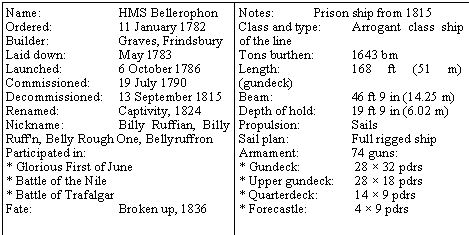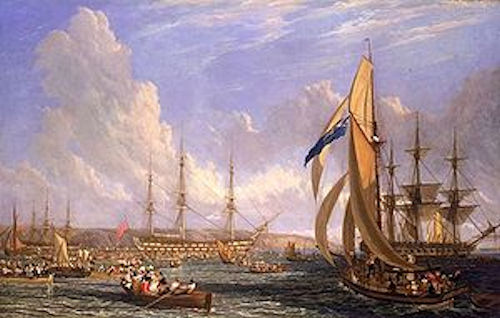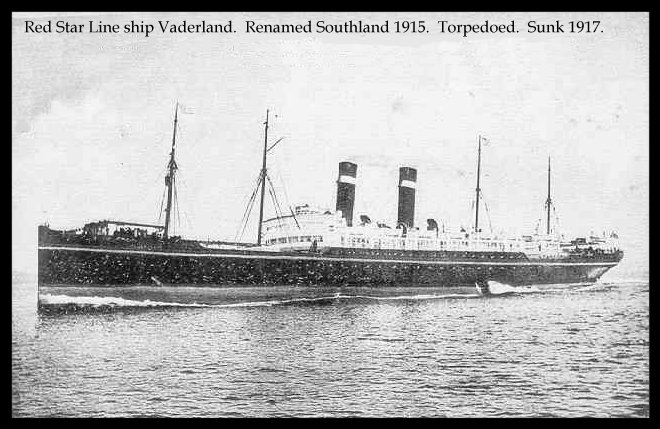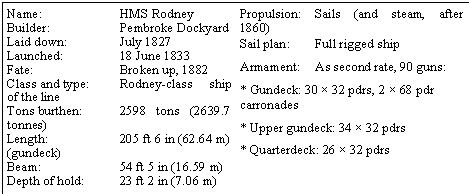

SOLLY - A DOVORIAN FAMILY'S WAR RECORD
By Collin Charles Solly
This article was originally published in the December 2009 edition of Soul Search, the journal of The Sole Society
This article reproduced from a local newspaper cutting from around 1924 (title unknown), found at the home of Charles Frederick Solly, Southend-on-Sea. Whilst clearing his loft of items after the death of his wife Joyce May Solly (Harding) in May, 2009.
The following is the interesting war record of the family of Mr Stephen Solly, of 13 Albany Place, Dover, Kent, England.
John Solly (Great-grandfather?) of Sandwich, Kent, in 1808 was seized by the “Press Gang for the Navy; served through the French Wars on H.M.S “Bellerophon”; was one of the crew told off to guard Napoleon at St. Helena; and was there until Napoleon’s death in April 1821.
Mr Stephen Solly, of 13 Albany Place, Dover aged 77 years; joined the 11th Foot (North Devons), in May, 1858 at Dover; marched from Curragh to Maryborough (22.5 miles) with King Edward the VII. (then Prince of Wales), 1860, who was then a lieutenant doing duty with the guards (training); hospital sergeant in India (Fizzabad, etc); with Lord Roberts in Abyssinian Expedition, 1860 (‘‘Bobs’’ was at that time D.A.Q.M.G., lieutenant, Bengal Army); was messenger to Mr William Russell the “Times” war correspondent, Franco-Prussian War, 1870; was valet to Field Marshall Lord Strathnairn, 1870,1875; at the Berlin Conference, 1871; meeting of Emperor at Berlin, also at the Vienna Exhibition, 1872 (his Lordship represented Queen Victoria as Commissioner).
Mr George Henry Solly (brother). Joined the Navy; went through the Russian and Crimean War, 1853-1855, H.M.S. “Rodney”; was wounded and discharged; settled at Sydney, New South Wales, Australia, where he became the father of seventeen children (mostly boys). The two youngest sons are now serving in the A.I.F. in France; also four grandsons are doing their “bit.”
Edward Solly (son) aged 28 years, No. 33653 Sapper, R.E; at the Front in 1915 and 1916; wounded and gassed; invalided and discharged.
Charles G. Solly (son), aged 35 years; was for eleven years in New York; joined United States 1st Contingent; now attached to the Middlesex Regiment.
Captain Harry Magnussen (nephew) Scottish Horse, N.S.W; rose from trooper to captain; twenty years’ good record; through Mashonaland, Zulu War, Boer War, Chinda, East Africa; and South Africa, 1900; now beyond age limit.
Arthur W. Magnussen, (nephew) aged 28 years. No. 4704 Q.M.S., A.I.F; Anzac, Gallipoli, Egypt; now at Rolleston with a training battalion.
Oliver W. Solly (nephew) aged 41 years, No. 897, A.I.F. Anzac, Sulva Bay; now with a Battalion at the Front.
George Henry Solly (nephew); Anzac; awarded the D.C.M. for stoking (with ten other men) the s.s. “Southland” when she was torpedoed.
William Fawley Solly (nephew) aged 23 years, No. 2573 Bandsman, Lancashire Fusiliers. Taken prisoner of war August 26th, 1914, during retreat from Mons, and is now at Sennelager.
Harry Solly (nephew) aged 27 years, No. 1911 Private, The Buffs. Twice wounded and gassed; Delvine Wood, etc.; now on permanent home service at the Mount, Shorncliffe.
William Solly (nephew) Trooper, 10th Hussars, 1915-1916; now discharged unfit.
Arthur Solly (nephew) Corporal, Royal Berkshire Regiment. Still on active service abroad.
Patrick Molloy (son-in-law) aged 50 years, C.S.M., R.G.A. Ten years in India; South Africa, 1900; after 12 years in New York volunteered for service; now with the Leinster Regiment as drill instructor.
George Pritchard (nephew) of Tower Hamlets Hill, Dover. Private, The Buffs. South Africa, 1900; rejoined, 1916.
William (Bob) Solley (cousin) of Sandwich. The Buffs. Came with the Buffs from India and went with the first Expeditionary Force; three times wounded and home on leave; killed 14th April, 1917. This soldier (Bob Solley) brought Lance-Corporal Rigden of 17, Limekiln Street, Dover, 400 yards when he was wounded on the 12th May, 1915, thus saving his life. Pte Solley was a married man.
Extra Information to above stories
John Solly (Great-grandfather?) of Sandwich, Kent, in 1808 was seized by the “Press Gang in 1808 for the Navy; served through the French Wars on H.M.S “Bellerophen”; was one of the crew told off to guard Napoleon at St. Helena; and was there until Napoleon’s death in April 1821.

Early history
She fought at the battle of The Glorious First of June, under the command of Captain William Johnstone Hope, where she lost 4 killed and 27 wounded. In 1798 she fought at the Battle of the Nile under Captain Henry D'Esterre Darby, who was wounded early in the action; she lost 49 killed and 148 wounded. She also fought at the Battle of Trafalgar in 1805, becoming one of the most famous British ships of the Napoleonic Wars. A letter to Henry D'Esterre Darby, her captain at the battle of the Nile, from Admiral Nelson, commander of the fleet at the battle, survives:
'My Dear Darby,
I grieve for your heavy loss of Brave fellows, but look at our glorious Victory. We will give you every assistance as soon as you join us, till then God Bless You.
Ever yours faithfully, Horatio Nelson
Aug 3rd 1798
We shall both I trust soon get well.'
Her crew affectionately called the vessel the Billy Ruffian (or Billy Ruff'n). At Trafalgar she was the fifth in Admiral Collingwood's Southern division and thus was heavily engaged, battling the French L'Aigle to a bloody standstill at the cost of her captain John Cooke dead, 26 other crew killed and 123 wounded. Command was ably assumed by her first lieutenant William Pryce Cumby, who safely steered the battered ship back to Gibraltar. On board during the battle was future Arctic explorer John Franklin, serving as a young midshipman.
Napoleon's surrender Napoleon Bonaparte on board the Bellerophon in Plymouth Sound by Sir Charles Locke Eastlake: 1815
She achieved further fame on 15 July 1815 when Napoleon Bonaparte surrendered to Captain Frederick Maitland of the Bellerophon and was transported to Torbay where the ship anchored off Brixham on 24 July. There Maitland received orders from Admiral Lord Keith. He was '...most positively ordered to prevent every person whatever from coming on board the ship you command, except the officers and men who compose her crew.'
In response to his orders, Captain Maitland refused to allow the usual visits of the boats full of traders with supplies of fresh food. John Michelmore, aboard one of the boats hoping to sell bread, saw a sailor in one of the lower gunports who signalled to them and then set adrift a small bottle containing a message that Bonaparte was aboard. He and the baker rowed ashore and the news quickly spread. While Maitland still kept boats from actually coming alongside, there were no further attempts to conceal the Emperor's presence. After two days, Bellerophon received orders to proceed to Plymouth harbour where Lord Keith was anchored aboard his flagship HMS Ville de Paris. Napoleon remained on board Bellerophon and the ship was still kept isolated from the throngs of curious sightseers by two guardships anchored close at hand. On 4 August, Lord Keith ordered Bellerophon to go to sea and await the arrival of HMS Northumberland which had been designated to take Napoleon into exile on St Helena. On 7 August, Napoleon left the Bellerophon where he had spent over three weeks without ever landing in England and boarded Northumberland which then sailed for St Helena.
References in Literature
At the beginning of Master and Commander, Patrick O'Brian's first book in the Aubrey-Maturin series of novels, the newly-promoted Jack Aubrey chances on a party of seamen when he is walking down to take command of his first ship:
'...some wearing broad striped trousers, some plain sailcloth; some had fine red waistcoats and some ordinary blue jackets; some wore tarpaulin hats, in spite of the heat, some broad straws, and some spotted handkerchiefs tied over their heads; but they all of them had long swinging pigtails and they all had the indefinable air of man-of-war's men. They were Bellerophons, and he looked at them hungrily as they padded by.'
Scene in Plymouth Sound in August 1815, by John James Chalon.
Bellerophon is at the centre of the picture, surrounded by crowds of people in small boats who have come to see Napoleon

George Henry Solly (nephew); Anzac; awarded the D.C.M. for stoking (with ten other men) the s.s. “Southland” when she was torpedoed.

In September 1915, Southland was torpedoed in the Aegean Sea by German submarine UB-14 with the loss of 40 men. The ship was beached, repaired, and returned to service in August 1916. While in service between the United Kingdom and Canada in April 1917, Southland was torpedoed a second time, this time by U-70; she was sunk off the coast of Ireland with the loss of four lives.
Mr George Henry Solly (brother). Joined the Navy; went through the Russian and Crimean War, 1853-1855, H.M.S. “Rodney” He was wounded and discharged, settled at Sydney, New South Wales, Australia, where he became the father of seventeen children (mostly boys). The two youngest sons are now serving in the A.I.F. in France; also four grandsons are doing their “bit.”
HMS Rodney was a two-deck 90-gun second rate ship of the line of the Royal Navy, launched on 18 June 1833 at Pembroke Dockyard. Rodney was fitted with screw propulsion in 1860, and was broken up in 1882.
